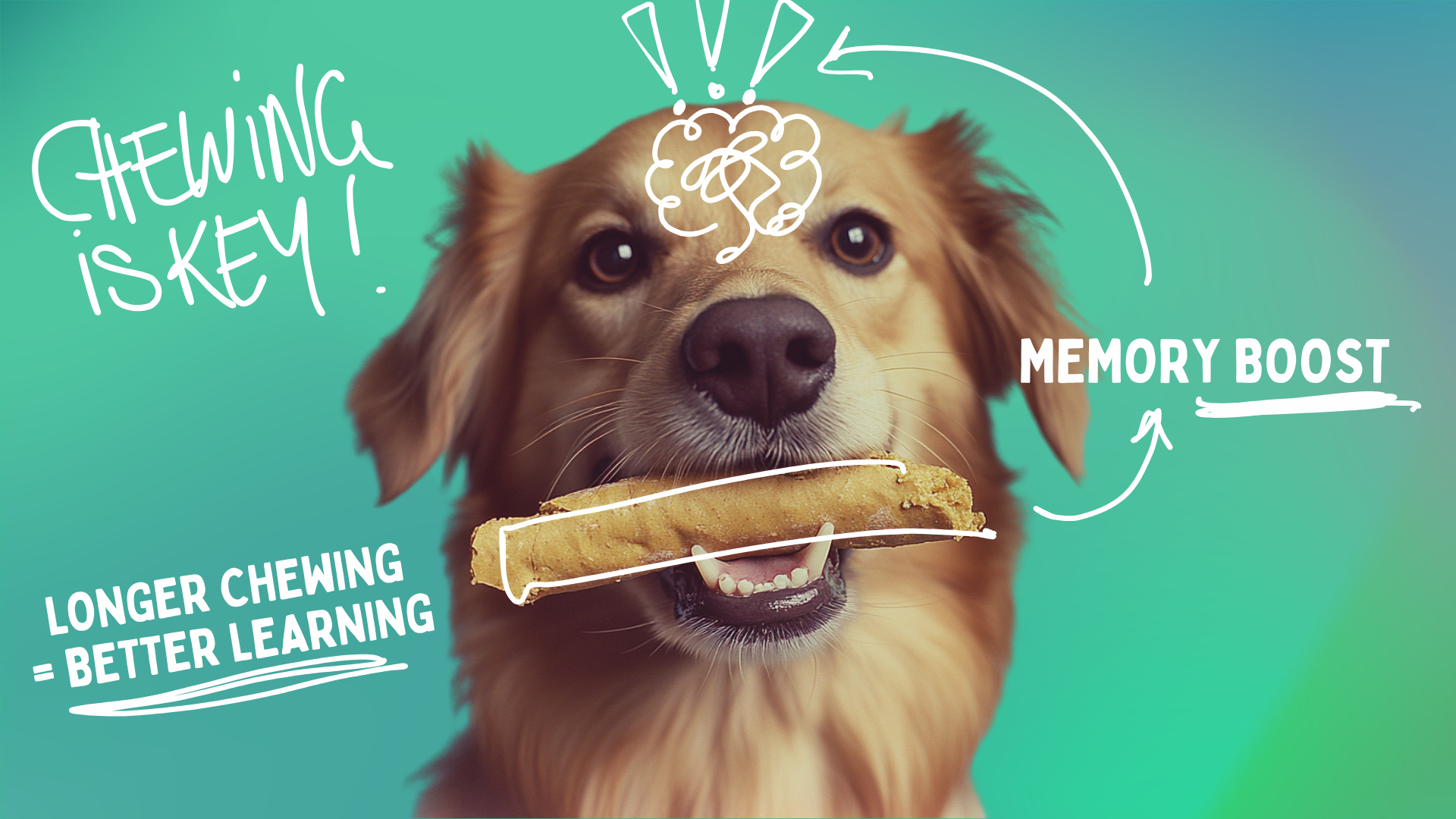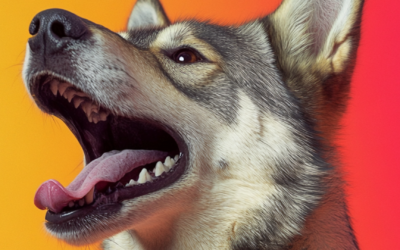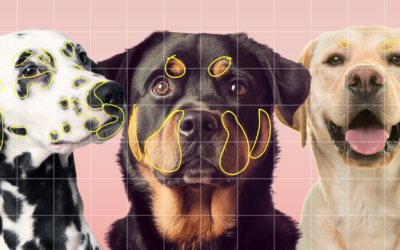Want smarter, faster learning? Just add chew time: How post-training chewing boosts canine memory
Chewing boosts memory after training
Longer chewing = better learning
Chewing may reduce stress and promote relaxation
A simple, effective training booster
Relevant for both dog professionals and owners

Let’s break down the science
behind the findings
Could chewing be the missing piece in your dog’s learning routine?
Imagine you’ve just wrapped up a focused training session. Your dog nailed a new cue or finally cracked that tricky scent task. What do you do next? Pack up? Go for a walk? Offer a cuddle?
What if the answer were simpler: just hand them a chew?
According to a fascinating new study by Moesta et al. (2025), allowing dogs to chew an edible, long-lasting treat after training meaningfully improves their memory—and speeds up future learning.
Especially for professionals working with time-sensitive training goals—like service dog programmes—or dedicated dog guardians striving to make progress at home, this kind of low-effort, high-impact insight can meaningfully change your approach.
What happens after training matters more than we thought
We already know that what happens during a training session is crucial—but increasingly, science shows that what happens afterward is equally important, particularly for long-term learning. This post-training window is when the brain solidifies new memories—a process called memory consolidation.
Previous studies have shown that activities like play and physical exercise immediately after learning can boost memory formation in dogs. The challenge? These activities require human involvement, energy, and time—not always practical. What if there were a low-effort, dog-driven alternative?
That’s where chewing comes in.
Chewing as a cognitive booster: What we already know
In humans and some animal species, chewing has been shown to be linked to attention, reduce stress, improve memory, and promote neuroplasticity—the brain’s ability to form and strengthen connections. Chewing has also been suggested to regulate emotional arousal, potentially helping animals remain calm under stress. But for dogs, scientific data has been limited so far.
One earlier observational study (Krichbaum et al. 2023) hinted at some benefits of chewing a chew toy on dogs’ cognition. But until the study by Moesta and colleagues (2025), the effect of chewing on long-term learning and training outcomes in dogs remained untested—or at least unproven.
Could a simple post-training chew improve memory consolidation, save time, and enhance training success? Could it be a practical tool for trainers and owners alike?
Moesta and colleagues set out to explore this question: Could prolonged chewing immediately after a training session enhance memory consolidation in dogs, making them relearn tasks more efficiently the next day?
Chewing vs. chomping: How the study was run
In this carefully controlled experiment, 31 kennel-housed dogs were trained in a classic object-discrimination task, where dogs had to discriminate between two objects, only one of which contained a treat. After training on Day 1, the dogs were split into two groups:
- Treatment group (16 individuals): These dogs were given a long-lasting edible chew.
- Control group (15 individuals): These dogs were given the same chew but crushed into pieces and mixed with wet food so it could be eaten quickly.
The key variable differing between groups? Chewing time. Dogs in the treatment group chewed for an average of 15 minutes, while control dogs spent just under 2 minutes eating their food.
The next day, all dogs repeated the learning task. The researchers assessed how quickly they could relearn the task and tracked how many sessions each dog needed to meet learning criteria again.
The researchers also monitored activity levels, heart rate, and heart rate variability (HRV) to explore whether chewing altered arousal or stress—factors potentially influencing memory.
What they found: Longer chewing, faster learning
The findings were clear and exciting: Dogs that chewed longer after training learned faster the next day.
Dogs in the chewing group required significantly fewer sessions to reach the learning criterion on Day 2 compared to the control group. Importantly, the effect wasn’t just about chew format—it was about chew duration. The more time dogs spent chewing (regardless of group), the faster they learned.
To put it plainly: chewing after training boosted memory consolidation—and did so without additional human intervention or training time.
Relaxed mind, better memory?
Why does chewing help memory? One possibility is that it calms the dog’s nervous system, creating an optimal environment for memory consolidation.
To explore this, Moesta and colleagues also measured the dogs’ heart rate variability—a proxy for stress levels and autonomic nervous system activity. While overall heart rate didn’t differ significantly between groups, one intriguing observation emerged:
Dogs in the chewing group showed signs of lower sympathetic activity (associated with stress) about 90 minutes after chewing, compared to controls. Heart rate variability measures hinted that chewing might help dogs enter a calmer, more parasympathetically dominant state (the “rest and digest” mode). While physiological data was limited due to sample size, it aligns with the idea that relaxation supports memory formation.
Why chewing might help memory
How exactly could chewing improve memory consolidation? Here are some possibilities:
- Reduced arousal and stress: A relaxed post-training state could support brain processes involved in solidifying learning.
- Minimised distractions: Chewing might help dogs focus internally, limiting interference from new stimuli.
- Enhanced neurophysiology: As observed in rodents and humans, chewing might activate brain regions linked to memory, like the hippocampus.
Researchers also speculate chewing might improve sleep quality, known to aid memory in both dogs and people. However, sleep was not measured directly in this study.
Put the science into practice
Let’s translate these findings into real-world applications for trainers, behaviourists, and dog owners.
Whether you’re a pet owner working on leash walking or a dog professional such as a detection dog handler refining alert behaviour, adding a post-session chew could help cement learning and reduce re-teaching time.
Key implementation takeaways:
- Offer your dog a long-lasting edible chew immediately after training—ideally promoting active chewing for 10–20 minutes.
- Allow your dog to settle in a calm, low-distraction environment while chewing.
- Be consistent: add a chew after key sessions and observe the impact over time.
A note on chew safety and suitability
- Choose products suitable for your dog’s size, age, and chewing style.
- Monitor initial sessions for safe chewing habits.
- Consider your dog’s dietary restrictions and nutritional needs.
Final thoughts: Small change, big impact
This study provides valuable insights for dog lovers looking to enhance learning with minimal effort. Chewing is natural, rewarding and scientifically shown to improve canine memory. Whether you’re working with service dogs, sport dogs, or family companions, a 15-minute chew after training could make all the difference between repetition and retention.
As Moesta and colleagues (2025) conclude, “Provision of an edible chew item post-training could speed up learning and improve efficiency of dog training”.
So go ahead—let your dog chew it over.
Reviewed by Alexandra Moesta, Board-Certified Veterinary Behaviourist and Senior Scientist at Royal Canin R&D Center.
Cite this paper summary as:
Dogs and Science (2025): Want smarter, faster learning? Just add chew time: How post-training chewing boosts canine memory (www.dogsandscience.com)
Publication:
Moesta, A. et al. (2025). Post-learning experience matters: Chewing after learning improves memory consolidation in dogs. Applied Animal Behaviour Science, 286, 106617. (LINK)
Feedback
At dogsandscience, we are always looking for ways to improve and provide the best experience for our customers. Your feedback is incredibly important to us, as it helps us understand what we’re doing well and where we can do better. Whether you have suggestions, comments, or simply want to share your thoughts, we truly appreciate your input. Every piece of feedback helps us grow and serve you better. Thank you for taking the time to share your experience with us!
Downloads
Get the PDF Version of this article:
Sign up and get our free Tool:
You have already signed up to our list? Enter your Passwort below and download the Tool.
Sign up to get your free Tool!
Subscribe to our newsletter to stay updated and get access to our exclusive Download Area.
Don’t miss out on important insights and discoveries about our canine companions!
After you have subscribed, you will receive an e-mail with your access to the download area.
More Content on Social Media:
You have already signed up?
Get our free Tool now.
Enter the passwort we’ve send you in an e-mail or go to the login area where you can download the tool and other free content.



